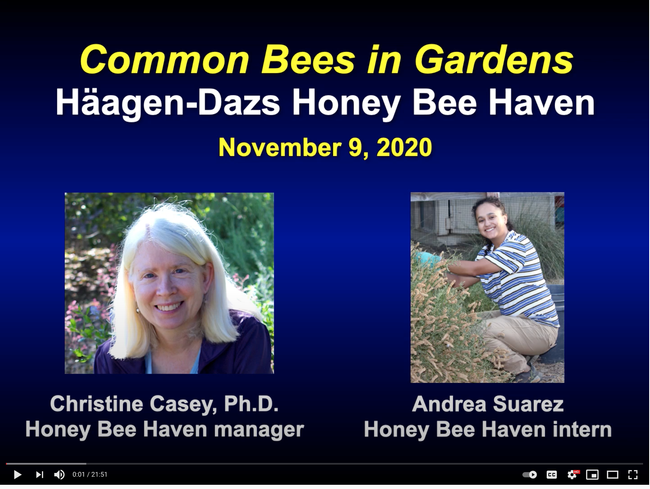The bee world exemplifies diversity and the UC Davis Biodiversity Museum Month, being celebrated throughout the month of February, wouldn't exemplify diversity without them.
One of the pre-recorded presentations just uploaded on the Biodiversity Museum site deals with bees in the UC Davis Department of Entomology and Nematology's bee garden, the Häagen-Dazs Honey Bee Haven on Bee Biology Road, west of the central campus.
The presentation, by bee garden manager Christine Casey, is an introduction to common bees found in urban gardens of Central California.
Many people are unaware that there are some 20,000 species of bees worldwide. Of that number, 4000 species are found in North America and 1600 species in California.
The late Robbin Thorp (1933-2019), UC Davis distinguished emeritus professor of entomology, was the go-to person to identify bees, and we all miss him. Thorp, a member of the UC Davis entomology faculty for 30 years, from 1964-1994, achieved emeritus status in 1994 but continued to engage in research, teaching and public service until a few weeks before his death at age 85. A tireless advocate of pollinator species protection and conservation, Thorp was known for his expertise, dedication and passion in protecting native pollinators, especially bumble bees, and for his teaching, research and public service. He was an authority on pollination ecology, ecology and systematics of honey bees, bumble bees, vernal pool bees, conservation of bees, native bees and crop pollination, and bees of urban gardens and agricultural landscapes.
In his retirement, Thorp co-authored two books Bumble Bees of North America: An Identification Guide (Princeton University, 2014) and California Bees and Blooms: A Guide for Gardeners and Naturalists (Heyday, 2014). Locally, he was active in research projects and open houses at the Bohart Museum of Entomology and the Häagen-Dazs Honey Bee Haven. In his research, he monitored bees in the half-acre haven, establishing a baseline in 2008, a year before the garden was installed. He eventually detected more than 80 species of bees in the garden.
Casey's presentation, billed as "Bees 101," documents some of the bees found in the garden, with colorful photos by the talented Allan Jones of Davis. Access the presentation at https://youtu.be/5KLrTIclx2A. Casey also will be delivering a live talk, with questions and answers, from 12:15 to 12:45 on Tuesday, Feb. 23. Click here to obtain the Zoom link.
Other UC Davis Biodiversity Museum Month live talks and demonstrations will range from Asian giant hornets (1 to 2 p.m. Feb. 18 by Professor Lynn Kimsey, director of the Bohart Museum of Entomology) to ants (11 a.m., to noon, Feb. 20 by Professor Phil Ward) to a program on the Botanical Conservatory (1 to 2 p.m., Feb. 24 by collections manager Ernesto Sandoval). To obtain the Zoom links, click here. The Botanical Conservatory presentation will be in Spanish. Sandoval earlier presented the program in English.
Note: If you'd like to donate to the UC Davis Diversity Museum Program in its crowdfunding efforts--this year is the 10th annual--click here. To donate to the Häagen-Dazs Honey Bee Haven, click here. To donate to the California Master Beekeeper Program, directed by Extension apiculturist Elina Lastro Niño of the UC Davis Department of Entomology and Nematology, click here. Niño also serves as the director of the haven.
Let's put the "bee" in bee-cause.
Meanwhile, as anyone who's been around bees knows, bees are not only absolutely fascinating, but thoroughly riveting.
Attached Images:
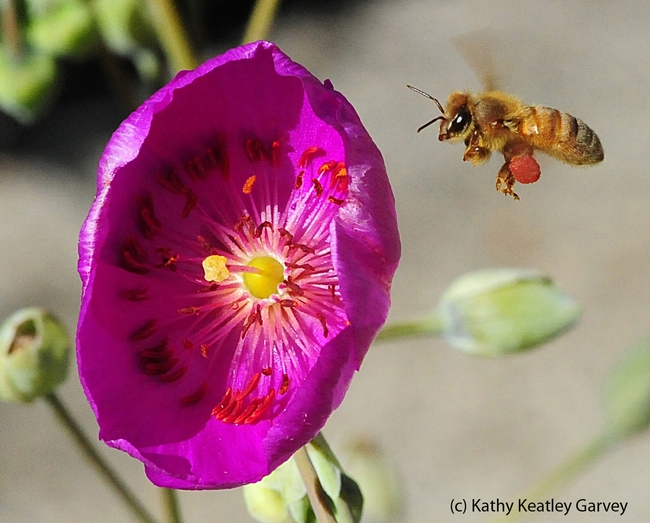
A honey bee in flight, packing red pollen from a rock purslane. (Photo by Kathy Keatley Garvey)
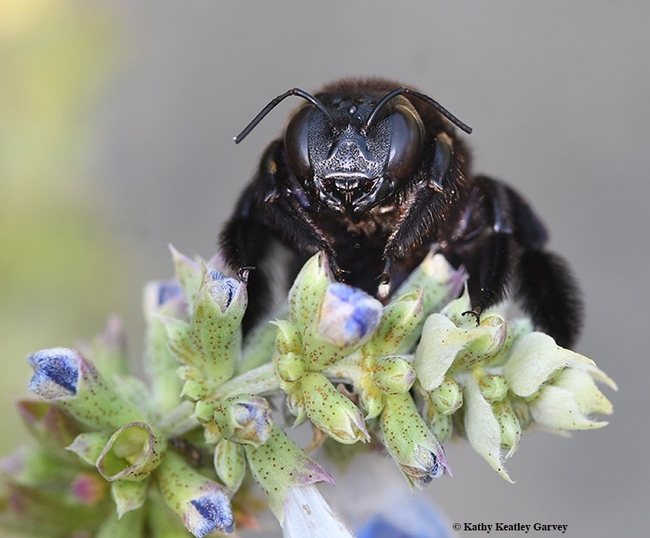
A female Valley carpenter bee, Xylocopa sonorina, formerly known as Xylocopa varipuncta. (Photo by Kathy Keatley Garvey)
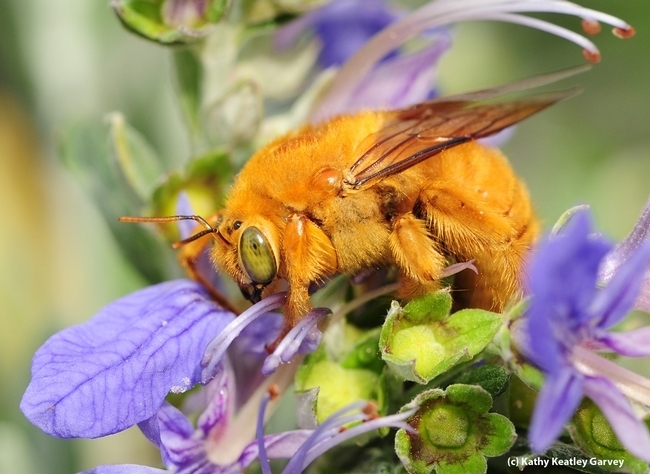
A male Valley carpenter bee, Xylocopa sonorina, which the late Robbin Thorp of UC Davis called "the teddy bear bee." (Photo by Kathy Keatley Garvey)

A yellow-faced bumble bee, Bombus vosnesenskii, foraging on the tower of jewels, Echium wildpretii. (Photo by Kathy Keatley Garvey)

A male leafcutter bee, Megachile spp., foraging on rock purslane. (Photo by Kathy Keatley Garvey)
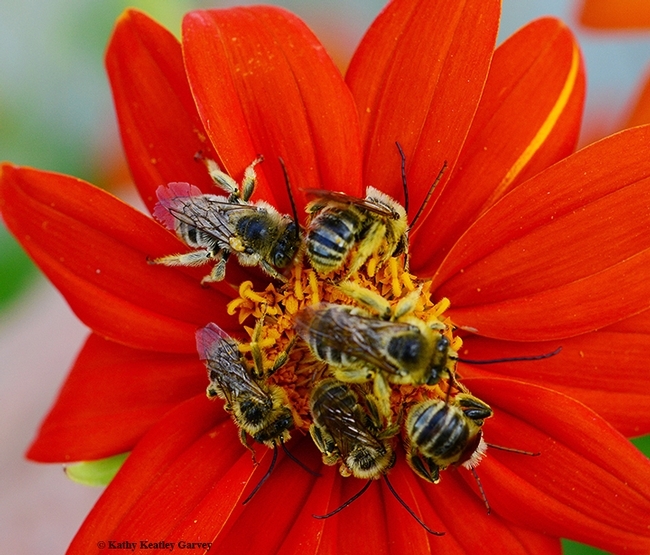
Male longhorned bees, Melissodes agilis, asleep on a Tithonia blossom. Females return to their nest at night; males cluster outside. (Photo by Kathy Keatley Garvey)
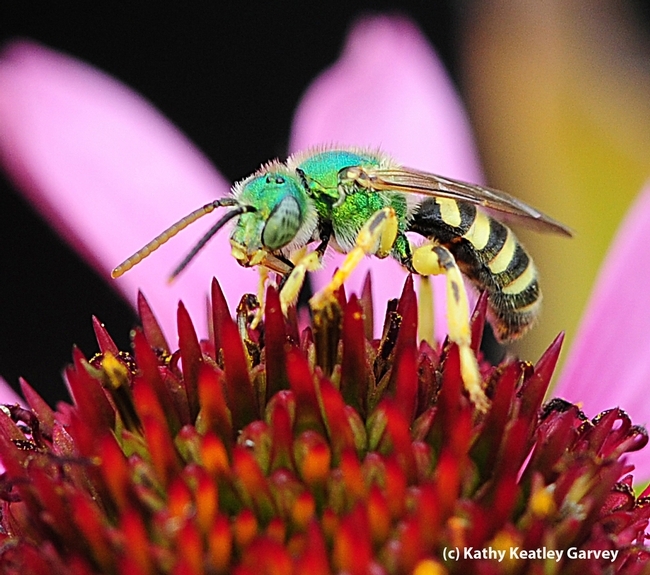
A male sweat bee, Agapostemon texanus, on a purple coneflower. (Photo by Kathy Keatley Garvey)
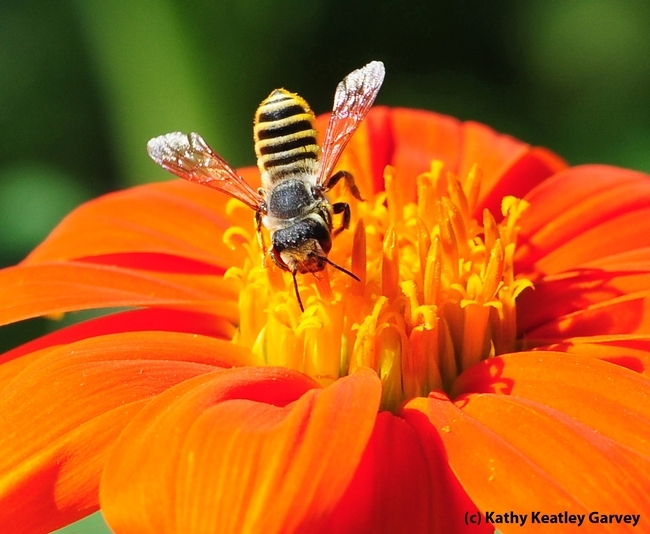
A female leafcutting bee, Megachile fidelis, foraging on a Mexican sunflower, Tithonia. (Photo by Kathy Keatley Garvey)
